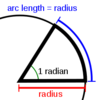Chap 4c - Circular Motion Flashcards
(82 cards)
CM stands for ____ ____
AND
LM stands for ____ ____
Circular Motion
AND
Linear Motion
It is easy to memorize the CM equations because they are exactly parallel to the _____________.
Linear Motion Equations
In linear motion, position is “x.” In CM angular position is_
theta

All points on a rotating wheel will have the same ________
Angular Velocity (they would also have the same angular acceleration, if any)

What is the difference between a positive and a negative angular velocity?
The direction the particle is travelling around the circle.
counterclockwise = positive.
clockwise = negative
angular position

The angle of a particle from the positive x-axis

The area under an angular acceleration graph is_
The change in angular velocity.



“v “ in LM
is like ___ in CM
omega
(angular velocity)

In circular motion, the symbol we will use to represent the period.

The slope of an angular velocity vs. time graph is_.
The angular acceleration
(alpha)

The equation below is for LM. What is the analogous equation for CM


“a” in LM
is like ____ in CM
alpha
(angular acceleration)

In CM,




Uniform circular motion
Moving at a constant speed around a circle of radius “r”
The equation below is for LM. What is the analogous equation for CM


What is the Greek symbol for Omega?









tangential acceleration
the acceleration parallel to the velocity of an object travelling in a circular path.















































































